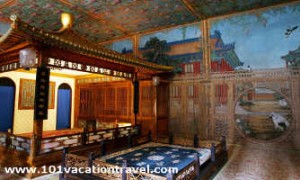Vacations in the Forbidden City
 Introduction to the Forbidden City
Introduction to the Forbidden City
The “purple city” (known for its purple colored roof tiles) hidden behind a forty-foot wall that was once a mystery to the people of Beijing has today become one of the most important tourist attractions in Beijing. The palace is called “Forbidden” City because no commoners without a job or an invitation was allowed no closer view. The Forbidden City is also known as the Imperial Palace or Palace Museum, and is located in the center of Beijing.
Architecture of the Imperial Palace
Built in the fifteenth century when the emperors of the Ming dynasty moved their seat of government from Nanking to the new capital of Beijing, the palace compound that is rich in treasures of art was the imperial residence of 24 emperors of the Ming and Qing (1368-1911) dynasties. A hundred thousand craftsmen, thousands of woodcarvers, painters, and gilding experts, and a million coolie slaves were engaged in the construction. The 178-acre palace site was to accommodate the imperial palace, housing for the royal entourage, and formal halls for official functions. Most of these early wooden structures were burned to the ground. Great changes were made during the rebuilding, hence the current architecture mainly dates from the eighteenth century.
Tour of the Forbidden City
The Forbidden City is divided into two main sections: the front palace to the south (Meridien Gate) and the inner palace to the north (Gate of Divine Might). The inner court is where the emperor and his imperial family lived. The outer palace, or the Hall of the Highest Harmony, is where the emperor issued commands and exercised his power over the nation. The adjacent Hall of Perfect Harmony served as a place for rest and meditation, and the Guardian of Harmony Hall was used for audiences and banquets. Today, archaeological treasures are exhibited there.
Symbol of Power
Given the size of the palace, the works of art shown in the Forbidden City is just too much to explore in a single visit. The interiors has priceless room partitions and engravings, large stone and bronze statues of Chinese mythology animals. Turtles and cranes are symbols of long life, and lions represents imperial power. There are nine thousand different rooms within the palace compound, mainly to accommodate the growing number of eunuchs and concubines across the years. Today, the golden chains worn by the concubines as a proof of status can be seen in the no longer forbidden Forbidden City.